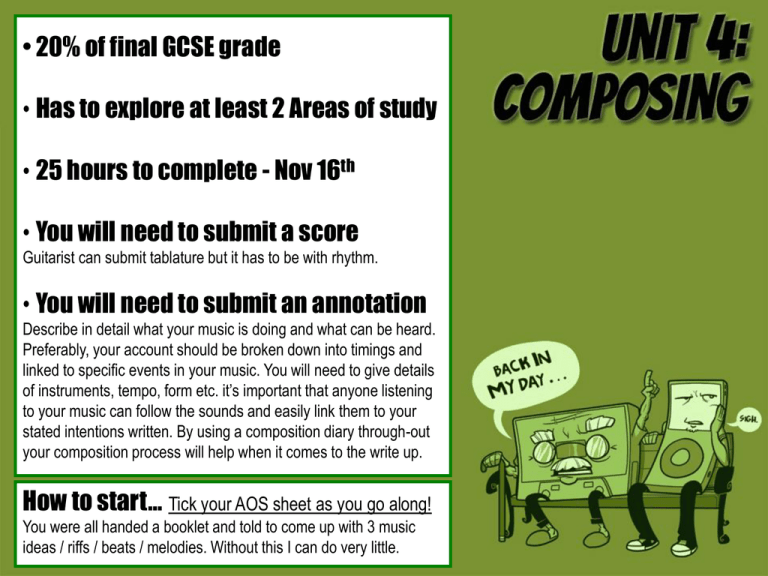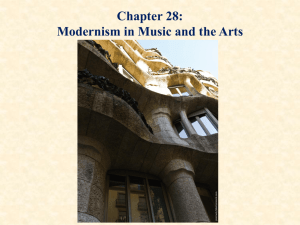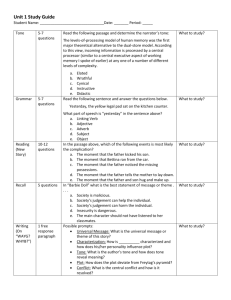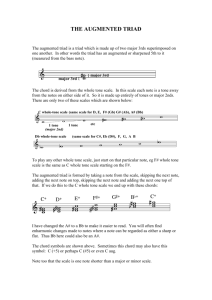To dominant
advertisement

• 20% of final GCSE grade • Has to explore at least 2 Areas of study • 25 hours to complete - Nov 16th • You will need to submit a score Guitarist can submit tablature but it has to be with rhythm. • You will need to submit an annotation Describe in detail what your music is doing and what can be heard. Preferably, your account should be broken down into timings and linked to specific events in your music. You will need to give details of instruments, tempo, form etc. it’s important that anyone listening to your music can follow the sounds and easily link them to your stated intentions written. By using a composition diary through-out your composition process will help when it comes to the write up. How to start… Tick your AOS sheet as you go along! You were all handed a booklet and told to come up with 3 music ideas / riffs / beats / melodies. Without this I can do very little. YOU WILL NEED… 1. MP3 of final recording 2. Screen shot of final dynamics 3. Annotation – Write up of techniques used and anything that cant be seen in the score 4. Signed CRF 5. Score / Final Cubase file as MIDI Tick your AOS sheets as you go along!! Chord sequence or riff? You need to have a chord sequence or a riff / melody to start composing. It doesn’t have to be long or something you love! Riff or melody Chord sequence DON’T SPEND AGES ON LYRICS!! I’m sorry if you had your heart set on writing a massive emo poem to a secret loved one but lyrical content will score you 0 marks. If singing, there has to be lyrics however don’t spend 5 hours on them. Take inspiration from a poem of a book – much easier. Listen to the lyrics for ‘come together’ by Michael Jackson Lesson 1: Chord sequence – Why start with a chord sequence? VERSE CHORUS A A When the night, has come. F#m F#m And the land is dark D E And the moon is the only A A Light we’ll see, so darling darling QUESTION: Which chords are used the most? Refer to numbers QUESTION: How many chords are used WHAT’S THE POINT? By using a scale you can’t go wrong TASK: (On the next slide) and finalise & play your chord sequence A Bm C#m D Tone I E Tone SemiTone Tone ii iii IV F#m G#dim A Tone V 4 chord magic I V IV IV A A Stand be me F#m F#m Ooooh Stand by me D Oh Stand E A Stand by me Stand by me Tone vi SemiTone VII VIII Extension task VERSE CHORUS A B C# D E … … … … … … … … F# G# A Extension task VERSE CHORUS … … … … … … … … HOW TO PLAY CHORDS How to play MAJOR chords… 1. 2. 3. Put your right thumb on any note you desire. Count up 4 notes and place your index finger there. Count up 3 notes and place your ring finger there. How to play DIMINISHED chords… 1. 2. 3. Put your right thumb on any note you desire. Count up 3 notes and place your index finger there. Count up 3 notes and place your ring finger there. In your books How to play MINOR chords… 1. 2. 3. Put your right thumb on any note you desire. Count up 3 notes and place your index finger there. Count up 4 notes and place your ring finger there. How to play 7th chords… 1. 2. 3. 4. Put your right thumb on any note you desire. Count up 3 notes and place your index finger there. Count up 4 notes and place your ring finger there. Count up 3 notes and place your little finger there. 7 TASK: As a class work out any major & minor chord… http://www.bgfl.org/bgfl/custom/resources_ftp/client_ftp/ks2/music/piano/index.htm COMPOSITION HELP: 1 Diatonic use of C major scale Cmaj Dmin Emin Fmaj Gmaj Amin Bdim Cmaj Tone Tone SemiTone Tone I II III Tonic Supertonic Mediant IV V Tone VI Sub-dominant Dominant All piano chords: http://www.8notes.com/piano_chord_chart/G.asp C major piano scale Tone SemiTone VII Sub-mediant Leading tone VIII Octave All guitar chords: http://www.8notes.com/guitar_chord_chart/ C major guitar scale COMPOSITION HELP: 2 Diatonic use of A major scale Amaj Bmin C#min Dmaj Emaj F#min G#dim Amaj Tone Tone SemiTone Tone I II III Tonic Supertonic Mediant IV V Tone VI Sub-dominant Dominant All piano chords: http://www.8notes.com/piano_chord_chart/G.asp A major piano scale Tone SemiTone VII Sub-mediant Leading tone VIII Octave All guitar chords: http://www.8notes.com/guitar_chord_chart/ A major guitar scale COMPOSITION HELP: 3 Diatonic use of D minor scale Dmin Edim Fmaj Gmin Amin Bbmaj Cmaj Dmin Tone Tone SemiTone Tone I II III Tonic Supertonic Mediant IV V Tone VI Sub-dominant Dominant All piano chords: http://www.8notes.com/piano_chord_chart/G.asp D minor piano scale Tone SemiTone VII Sub-mediant Leading tone VIII Octave All guitar chords: http://www.8notes.com/guitar_chord_chart/ D minor guitar scale COMPOSITION HELP: 4 Diatonic use of A minor scale Amin Bdim Cmaj Dmin Emin Fmaj Gmaj Amin Tone Tone SemiTone Tone I II III Tonic Supertonic Mediant IV V Tone VI Sub-dominant Dominant All piano chords: http://www.8notes.com/piano_chord_chart/G.asp A minor piano scale Tone SemiTone VII Sub-mediant Leading tone VIII Octave All guitar chords: http://www.8notes.com/guitar_chord_chart/ A minor guitar scale COMPOSITION HELP: 5 B Harmonic minor scale Bmin C#dim Daug Emin F#maj Gmaj A#dim Bmin Tone SemiTone Tone I II III Tonic Supertonic Mediant Tone SemiTone Minor 3rd Semi Tone IV VI Sub-dominant Dominant All piano chords: http://www.8notes.com/piano_chord_chart/G.asp B Harmonic minor scale V VII Sub-mediant Leading tone VIII Octave All guitar chords: http://www.8notes.com/guitar_chord_chart/ B Harmonic minor guitar scale Bass lines TASK 1: Bass lines don’t just follow the chord sequence, but they can. Imagine stand by me with out the bass line (listen and demonstrate chord sequence). TASK 2: Now listen to bass line… The song would be nothing without. TASK 2: In the key of A what notes does it use and does it stray far from the chord? A Bm C#m D Tone I E Tone SemiTone Tone ii iii IV F#m G#dim A Tone V Tone vi SemiTone VII VIII Bass lines Types of bass line... Bass line TASK 1: Listen and discuss what you can use from these examples. TASK 2: Compose a bass line - You did this in year 9 so doing it in year 11 will be no problem. EXTENSION TASK: Bass line for your verse. (if you did one last week). Drums TASK 1: Know the drum Kit Snare Drum Cymbal Tom-toms Bass Drum Hi Hat KNOW: How to pitch a Bass line BE ABLE TO: Compose a Bass line for your groups song UNDESRATND: The role of a Bass http://www.drumnuts.com/GAMES/Virtual-Drums-Buckle.php PUPIL MODEL: How they can achieve & 2 & 3 & 4 & 1 & 2 & 3 & 4 & LEVEL 5 Drum Count Drum 1 LEVEL 4 Count Drums (With a drum fill – What is a drum fill?) Drums SYNCOPATION 1 & 2 & 3 & 4 & LEVEL 6 Drum Count Syncopation is where the accent is shifted from the main beat to a weaker beat. It’s a rhythm where the beats have different spacing's between them. Try and come up with your own syncopated rhythm. (With a drum fill – What is a drum fill?) Riff / Hook Float on – Modest mouse Tinne Tempah – Pass out What you know – Two door cinema club KNOW: What a Riff is BE ABLE TO: Compose a riff / hook for your groups song UNDESRATND: Composition from a scale STARTER: What do all 4 songs have in common RAGE – Killing on the name of Riff / Hook A Bm C#m D Tone I Tone SemiTone Tone ii iii C# C# E E F# E E IV F# E C# F#m G#dim A Tone V C# C# Tone vi C# A SemiTone VII C# E G# F# VIII E C# G# A G# This song is in the key of A major / F# minor and uses those two chords TASK 1: Look at the note used in the riff. Are they only notes from the A major scales? good riff will use long and short length notes as well as rests. TOP TIPS AIf it’s catchy your mate will be able to sing it back to you. B GUITAR DRUMS PIANO http://www.youtube.com/watch?v=T_v1TgVEX7Y http://youtube.googleapis.com/v/TroJUuyUP1Y STRINGS LESSON 5 Pizzicato / Plucked Strummed Bowed Block chords & Arpeggio Arpeggio Rim shot Picked Muted Change of Time Signature Use a minimum of 2 of the following; 2/4, 3/4, 4/4 & 6/8. Maybe try a free meter or an irregular time signature like 7/8 for top marks Change of Tempo Use a minimum of 2 different tempos. Make them obvious! You could also speed up or slow down. Listen 2:18 onwards. Rallentando Use a mixture of note lengths / Durations = Whole = 1/2 = 1/4 = 1/8 = 1/16 Triplets: Dotted rhythm: Swing time Syncopation: The accent is shifted from the main beat to a weaker beat. Polyrhythm: 2 or more rhythms being played at the same. Augmentation: A section repeated as a longer version, often with note values doubled. A section repeated as a shorter version, often with note values halved. Diminution: Rubato & Hemiola: Research these and if you can include them for A* marks.. If you’ve chosen AoS:1 your composition must have… BEFORE COMPOSING CHOOSE A KEY! See earlier slides or next slide… Use a mixture of chords Major Chords. Minor chords. Diminished chords. 7th chords. If you’ve chosen AoS:2 your composition must have… Change of Tonality You must change tonality at least once through-out the piece. So use at least two of the following... Major, minor or modal Use a Pedal or a Drone or both! Pedal - http://www.youtube.com/v/Pgum6OT_VH8&ob=av2n Drone- http://www.youtube.com/watch?v=6a3NcwfOBzQ Use a variety of Cadences: Make them obvious!!!! Second last chord V IV I, II or IV V Last chord I I V Any bar I Cadence = = = = Perfect Plagal Imperfect Interrupted Change key / Modulate: Keep the same tonality just taking the whole thing up a tone or semi-tone. By doing this you’ve taking the piece to a new key. 2:20mins. Change key / Modulate: To dominant (V). To Subdominant (IV). To relative major. To relative minor. Up a tone. HARMONY: 2 or more notes played / sung at the same time Create a Harmony Consonant - Nice. Dissonant - clashing. Diatonic – Uses only the notes of the key. Chromatic uses notes that don’t belong in the key. Create a Harmony Using a mixture of intervals Interval song: http://www.youtube.com/watch?v=nl2d4zS56cY Multiple Textures: Use lots of different textures Homophonic: The melody follows the chords 2 or more melodies played at the same time of equal importance. Polyphonic: Single line melody: An unaccompanied melody. Melody with accompaniment: Melody with band providing accompaniment. Unison: All the instruments play notes at the same pitch – Vocals & instruments. Octaves: All the instruments play the same note at different pitch http://en.wikipedia.org/wiki/Homophony Use multiple melodic note patterns: When writing vocal lines or any melodic lines try to vary each one. Conjuct: Melody that moves mainly by step never more than a tone. Doesn’t jump around and sounds smooth. Disjuct: Melody that moves using lots of jumps. Larger than a tone. Triadic: Melody that moves using notes of the triad Scalic: Melody that moves up and down using only the notes of a scale. They only move to the next note up or down in the scale Use Articulation across your composition Short stabs. Much easier than writing in a rest mark. Passing note Tenuto accents mean the notes are to be played at full length or even slightly longer. Make your bass lines or chords interesting by including a few. Riff This sign means the note should be played louder Short, repeated melodic phrase. Definitely use!!! Appoggiatura: Acciaccatura: Pitch bend: A dissonant note that is approached by a leap, and then moves by step to resolve on to a harmony note. A quick note that happens before the main one. Short slide up or down to another note (The wheel on end of the keyboard). Sequence A sequence is where a melodic phrase is immediately repeated at a different pitch, often step by step. If the sequence gets higher in pitch its called an ascending sequence. Alternatively, the pitch get lower, in which case it is a descending sequence. The pitch must remain within the scale otherwise that is simply known a key change. Improvisation Creating new musical ideas on the spot, during a performance. Slide / Glissando Melodic device: literally sliding from one note to another. http://www.youtube.com/v/0N22_L7qAtw Trill Turn http://www.youtube.com/watch?v=FlEo8WUClNk Rapid movement back & forth between the note. A turn consists of the note above the one indicated, the note itself, the note below the one indicated, and the note itself again. = = http://upload.wikimedia.o rg/wikipedia/en/1/18/Trill _example_A-B-C.mid Repetition Melodies can be repeated. Use a variety of scales Use as many different scales as possible. Major: Tone > Tone > SemiTone > Tone > Tone > Tone > SemiTone Minor: Tone > SemiTone > Tone > Tone > SemiTone > Tone > Tone Chromatic: All semi tones only Modal: Different starting points of a major scale Dorian, Phrygian, Lydian, Mixolydian, Locrian, Whole tone: All tones only Pentatonic: I II Blues: bIII I III V VI of any major scale IV bV V Use a range of intervals Using a mixture of intervals bVII of any major scale Interval song: http://www.youtube.com/watch?v=nl2d4zS56cY Samples www.freesound.org – List of sample you may want to include Reverb Chorus Distortion Sound lasts longer because it’s being reflected. Multiplying the instrument or vocal line. Makes the instrument or voice sound fuzzy. Compression Boosts the quiet parts of a song so they match the loud parts. Thus creating one dynamic. Sequencer A device / program used to record, edit and playback music / MIDI Panning Sound is electronically placed into one speaker / ear or moves from one ear to the other. (also based on percentages). Vocoder An electronic device for synthesising speech. It’s half human voice and instrumental pitch 2:20. http://www.youtube.com/watch?v=bjPqsDU0j2I Multi-tracking Recording device where different tracks are recorded separately and then played back together. If you’ve chosen AoS:4 your composition must have… Timbre: Get it right Timbre is a difficult one to ensure, seeing as you have to have instruments for there to be music. It’s about making the instrument sound like it should. For example a violin shouldn’t sound like a bass and a bass guitar shouldn’t be sounding like a banjo. Also when choosing an instrument make sure you apply all of the particular playing techniques. Dynamics: Include a mixture – More than 2 Listen Regina Spektor’s ‘The Call’ has an excellent range of dynamics. Click on face to play. GOOD! – Carefully craft sections. BAD! – Don’t just draw lines for the sake of it! Drum techniques Guitar techniques String techniques http://www.youtube.com/watch?v=cw9yk7ZkuGc http://www.youtube.com/watch?v=s9iaSp77xB8 There aren’t as many opportunities with this AoS. 1. Instrumental forms: Ground bass. Continuo. Cadenza. 2. Classical forms: Strophic. Through-Composed. 3. Pop song forms: Strophic. Middle 8. Verse chorus. 12 bar blues 4. Structures: Binary. Ternary. Call and Response. Rondo. Arch shape 5. Classical works: Concerto. Sonata. Symphony. Suite PAGE 166 of AQA GCSE MUSIC BOOK – Read it! Keep a log / diary Now you know what needs to go into your composition it’s worth keeping a diary and logging what you’re including. Ensure you include what track your editing, and what time it happens. Example: 0:56 – I’ve added a ‘trill’ to the piano part. 1:26 – I’ve deleted my initial bass line. 1.67 – I’ve added a passing note between chord A and Bmin How to write a R n B ballad Everything you need to write a love song. Lots of little bits make up a song Lots of little parts make a massive song. Watch this video clip and see how lots of short loops can make a really big song. Progression and chorus When to change in music? Question: What’s the time signature of this piece? Question: on average how many bars until the music changes? Every chorus the same? Question: Compare the 1st and 2nd chorus. Does this give you any ideas for your composition? Families http://www.dsokids.com/listen/instrumentlist.aspx BRASS STRING WIND PERCUSSION Starting a song How to start a song? How are these intro’s similar? A simple solution to sorting out your intro? FREESOUND.org = Free Samples Primary chords: 1st, 4th and 5th notes of the scale In the key of C major Secondary chords: 2nd, 3rd and 6th notes of the scale In the key of C major TASK: What are the primary and secondary chords for G major and D major?







